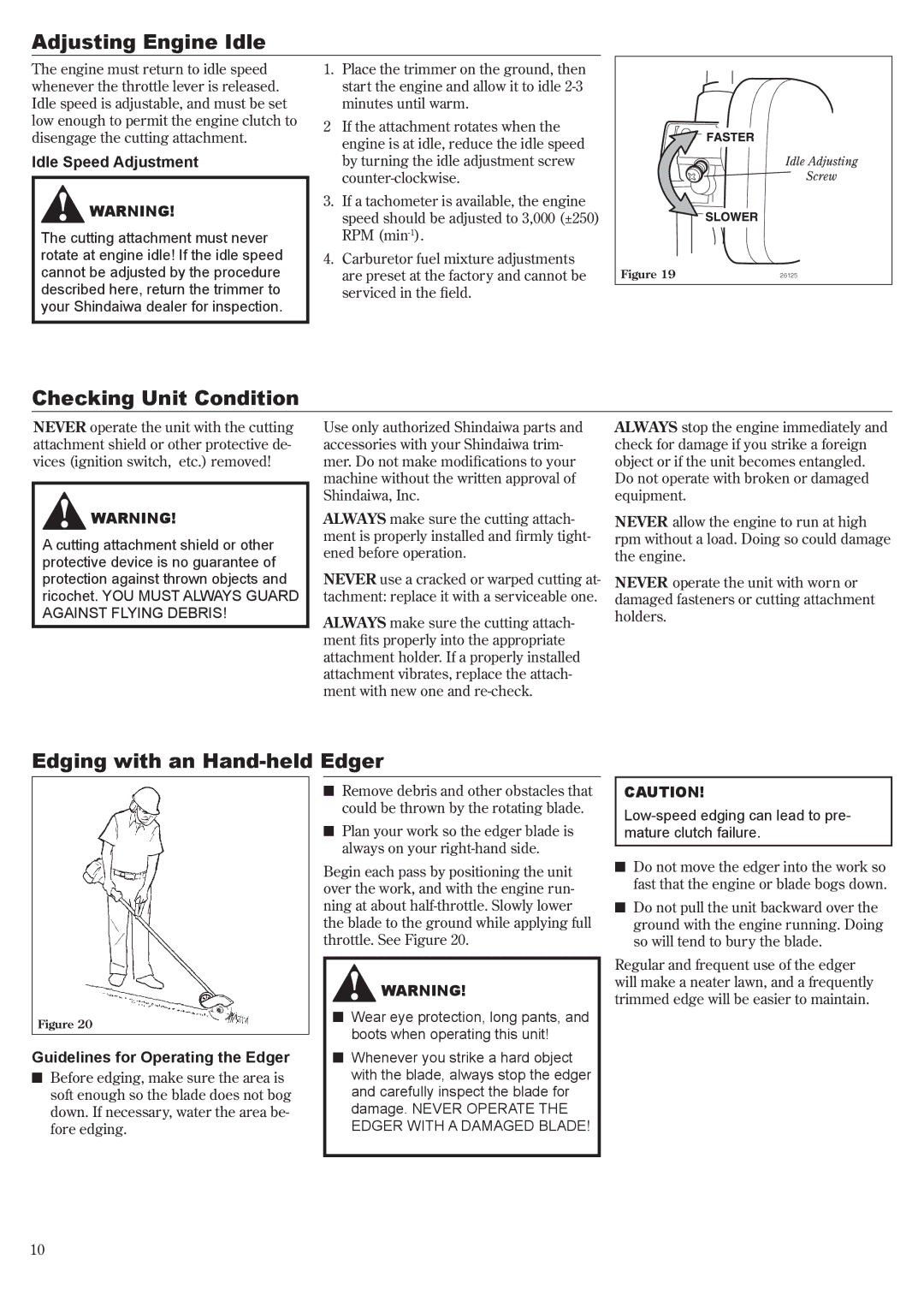
Adjusting Engine Idle
The engine must return to idle speed whenever the throttle lever is released. Idle speed is adjustable, and must be set low enough to permit the engine clutch to disengage the cutting attachment.
Idle Speed Adjustment
![]() WARNING!
WARNING!
The cutting attachment must never rotate at engine idle! If the idle speed cannot be adjusted by the procedure described here, return the trimmer to your Shindaiwa dealer for inspection.
1.Place the trimmer on the ground, then start the engine and allow it to idle
2If the attachment rotates when the engine is at idle, reduce the idle speed by turning the idle adjustment screw
3.If a tachometer is available, the engine speed should be adjusted to 3,000 (±250) RPM
4.Carburetor fuel mixture adjustments are preset at the factory and cannot be serviced in the field.
Idle Adjusting
Screw
Figure 19 | 26125 |
Checking Unit Condition
NEVER operate the unit with the cutting attachment shield or other protective de- vices (ignition switch, etc.) removed!
![]() WARNING!
WARNING!
A cutting attachment shield or other protective device is no guarantee of protection against thrown objects and ricochet. YOU MUST ALWAYS GUARD AGAINST FLYING DEBRIS!
Use only authorized Shindaiwa parts and accessories with your Shindaiwa trim- mer. Do not make modifications to your machine without the written approval of Shindaiwa, Inc.
ALWAYS make sure the cutting attach- ment is properly installed and firmly tight- ened before operation.
NEVER use a cracked or warped cutting at- tachment: replace it with a serviceable one.
ALWAYS make sure the cutting attach- ment fits properly into the appropriate attachment holder. If a properly installed attachment vibrates, replace the attach- ment with new one and
ALWAYS stop the engine immediately and check for damage if you strike a foreign object or if the unit becomes entangled. Do not operate with broken or damaged equipment.
NEVER allow the engine to run at high rpm without a load. Doing so could damage the engine.
NEVER operate the unit with worn or damaged fasteners or cutting attachment holders.
Edging with an Hand-held Edger
Figure 20
Guidelines for Operating the Edger
Before edging, make sure the area is soft enough so the blade does not bog down. If necessary, water the area be- fore edging.
Remove debris and other obstacles that could be thrown by the rotating blade.
Plan your work so the edger blade is always on your
Begin each pass by positioning the unit over the work, and with the engine run- ning at about
![]() WARNING!
WARNING!
nWear eye protection, long pants, and boots when operating this unit!
nWhenever you strike a hard object with the blade, always stop the edger and carefully inspect the blade for damage. NEVER OPERATE THE EDGER WITH A DAMAGED BLADE!
CAUTION!
Low-speed edging can lead to pre mature clutch failure.
Do not move the edger into the work so fast that the engine or blade bogs down.
Do not pull the unit backward over the ground with the engine running. Doing so will tend to bury the blade.
Regular and frequent use of the edger will make a neater lawn, and a frequently trimmed edge will be easier to maintain.
10
